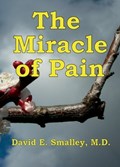This Miracle of Pain eBook (131,086 words) is distributed by Smashwords. It has a full color front cover and is in the Health and Self-help categories of books. The book is written for a general audience, especially for those dealing with acute or chronic muscle and joint pain. It is for persons, their family and friends who are looking for better ways to deal with pain, when what they are trying is not working. There are 12 color and 7 grayscale original illustrations, internal and external hyperlinks. It is fully searchable.
I recount personal experiences with pain, beginning at the age of 5, when I was hospitalized for over 3 months with a severe autoimmune illness and pain. My injuries since then have taught me more about pain, especially after medical school. During my practice of orthopedic surgery, trauma surgery and spine surgery, I enjoyed learning from my patients. In the 1980s, three spine patients, all with severe pain, sparked for me an intense learning experience while dealing with their challenging conditions, including cancer of the spine.
The true stories and principles I teach have worked for the benefit of many people. Experimenting with the principles has helped my own health challenges. Understanding the healing capacity of the human body gives hope and perspective. How average persons get into trouble trying to copy elite athletes in the news is reviewed to give perspective for the rest of us.
With my busy orthopedic surgery practice and family, I needed help to start the book in 1998. That year, of many Workers' Compensation depositions, one of them was what I needed to get me started putting things down on paper. Two attorneys told me they just wanted to know what I knew about reflex sympathetic dystrophy, a chronic pain disorder. They asked because I had functioned as an evaluator for a patient about 6 months before, agreed to by attorneys for both the patient and the employer. They said that I was the only doctor, of four others, who had correctly diagnosed the pain. They also said that the other doctors later acknowledged that I was right because the findings later became more obvious.
After writing most of the book and 30 years of practice, I retired in January 2010. I describe physical, emotional and spiritual tools that can alleviate all levels of pain, whether it is from automobile accidents or from an ankle sprain. One of the simplest tools is when to use ice or heat, but there are many other good tools. How to recognize them and ways to keep from misusing them are given. Pain that is not improving, as expected, is all too common and frustrating for patients and doctors. Solutions for dependencies and addictions of many kinds are addressed.
What I learned about pain as a patient and as an orthopedic surgeon includes timeless principles and ideas that will help alleviate the ongoing opioid abuse epidemic. By hearing and understanding true stories and with the application of principles, many painful musculoskeletal problems can be resolved.

